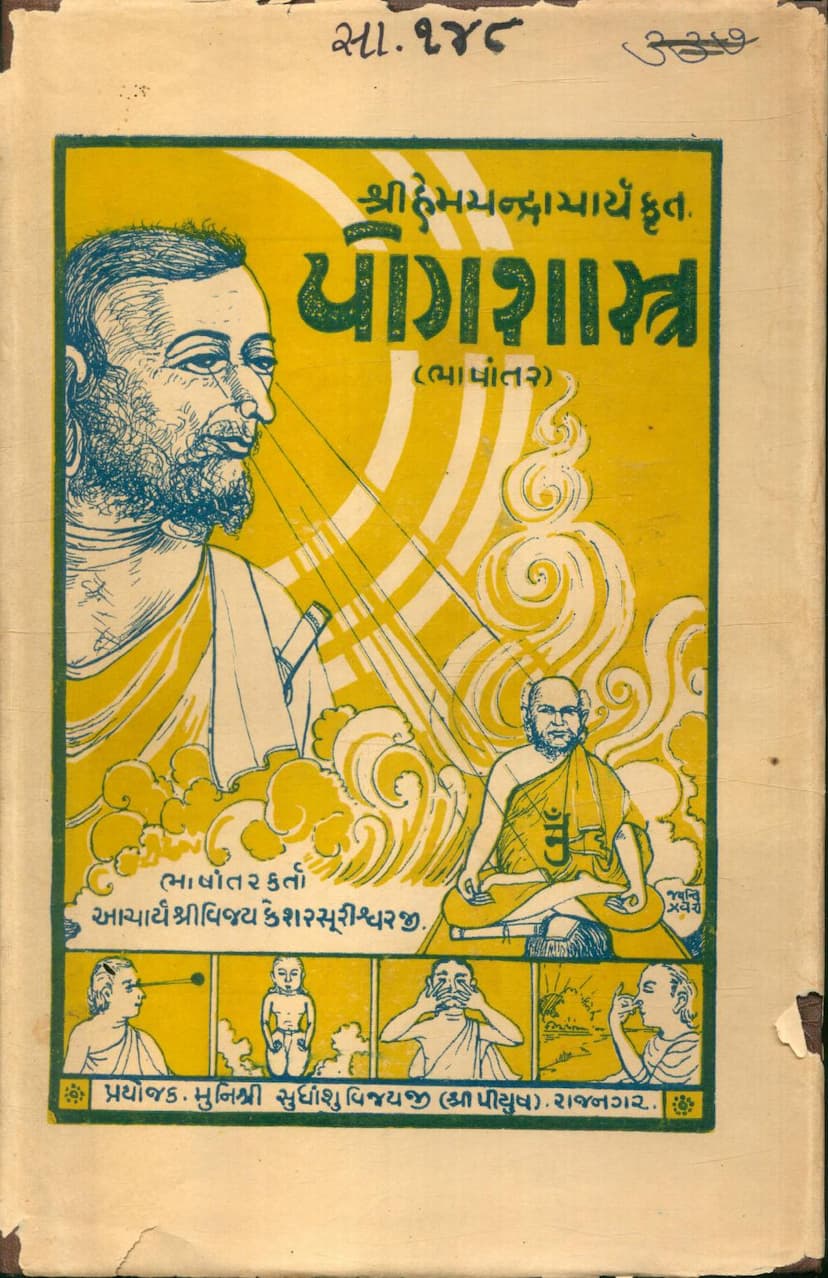Yogshastra
Added to library: September 2, 2025

Summary
The book "Yogashastra" by Hemchandracharya, translated by Acharya Shri Kesarsuri, and inspired by Muni Shri Sudhanshuvijayji, is a significant Jain text that explores the path of Yoga for spiritual liberation. The provided text, a translation and commentary, offers a comprehensive view of Jain Yoga. Here's a summary of its key aspects based on the provided pages:
Core Concepts of Jain Yoga:
- Yoga as the Means to Liberation (Moksha): The central theme is that Yoga is the ultimate cause for achieving Moksha, the highest spiritual goal in Jainism. It emphasizes that this path transcends worldly happiness and is the only way to overcome the cycle of birth, death, and suffering.
- Self-Realization through Yoga: The text stresses that the true essence of Yoga lies in understanding and realizing the soul (Atman) itself. It posits that the soul is inherently pure but has become obscured by impurities like Maya and karmic bonds. Yoga is presented as the process of removing these impurities.
- Purity of Mind, Speech, and Body: The initial stages of Yoga involve purifying thoughts, speech, and actions. This means eradicating impure or inauspicious thoughts, words, and deeds while cultivating auspicious ones. The ultimate aim is to reach a state where even in dreams, there are no impure activities.
- The Importance of the Soul (Atman): The text identifies the soul as the ultimate truth and emphasizes introspection and self-discovery. It is not about finding something external but about uncovering the inherent nature of the soul, which is already present.
Key Principles and Practices:
- Destruction of Karma: A significant aspect of the Yogashastra is its emphasis on Yoga's power to destroy even long-accumulated karma, akin to how a strong fire can instantly burn a large pile of fuel. This highlights the transformative power of dedicated spiritual practice.
- Attainment of Siddhis and Siddhis: The text describes various spiritual powers or 'siddhis' attainable through Yoga, such as levitation, control over others, clairvoyance (Avadhijnana), and telepathy (Manahparyaya). These are described as the blossoming flowers of the Yoga tree.
- Ethical Foundations (Yamas and Niyamas): While the full extent isn't detailed in the initial pages, the text mentions principles like Ahimsa (non-violence), Satya (truth), Asteya (non-stealing), Brahmacharya (celibacy/chastity), and Aparigraha (non-possession) as foundational. It elaborates on these Yamas with 'Bhavanas' (meditative contemplations) to strengthen their practice.
- The Eight Limbs of Yoga (Implied): While not explicitly listed as such in the initial summary, the text discusses various practices that align with the eight limbs of Yoga: Yamas (Ahimsa, Satya, etc.), Pratyahara (sense withdrawal), Dharana (concentration), Dhyana (meditation), and Samadhi (contemplation). It delves into the nature of Asanas (postures), Pranayama (breath control), and their role.
- The Role of Meditation (Dhyana): Meditation is presented as a crucial tool for purifying the mind, achieving concentration, and ultimately realizing the soul. The text describes different types of meditation and the stages of progressing through them.
- The Importance of a Guru: The text indirectly highlights the need for guidance, as the translator, Kesharsuri, dedicates the work to his guru, Acharya Shri Vijaykamalsurishwarji, underscoring the importance of a spiritual preceptor.
Hemchandracharya and Kumarapala:
- Origin of the Text: The "Yogashastra" was composed by the renowned Jain scholar Hemchandracharya at the request of King Kumarapala of Gujarat.
- King Kumarapala's Devotion: The text illustrates Kumarapala's deep interest in Yoga, mentioning that he had memorized the "Yogashastra" and recited it daily. It also recounts an incident where this practice was used as a penance, highlighting its significance in the king's life.
- Hemchandracharya's Scholarly Prowess: The text references Hemchandracharya's extensive knowledge and his ability to explain profound subjects, even to royalty, thereby influencing societal reforms like the prohibition of meat-eating and alcohol.
The Translator and Publisher:
- Acharya Shri Kesar Suriji Maharaj: The translator, a renowned scholar and ascetic, dedicated this translation to his guru. His introduction emphasizes the decline of Yoga studies in India due to the influence of materialism and the need to revive this vital spiritual knowledge.
- Munishri Sudhanshuvijayji (Shri Piyush): He is credited as the inspiration and motivator for this translation and its publication, aiming to make this profound knowledge accessible to the Gujarati-speaking community.
- Balchand Sakarchand Shah: The publisher, playing a role in disseminating this important work.
Critique of Materialism and Emphasis on Inner Knowledge:
- The introduction strongly criticizes the modern world's focus on material science ("Jad Vidya") at the expense of spiritual and self-knowledge ("Atmavidya"). It laments the decline of Yoga in India due to Western influence and warns of a potential future where India might become devoid of this profound self-knowledge if not actively preserved and promoted.
- The text calls for a shift in focus from external pursuits to internal exploration, emphasizing that true happiness and eternal bliss reside within the soul.
Key Takeaways:
The "Yogashastra," as presented in this translation, is a guide to achieving ultimate liberation through the disciplined practice of Yoga. It offers a holistic approach, emphasizing ethical conduct, mental discipline, and spiritual realization as interconnected paths. The text serves as a reminder of the rich spiritual heritage of India and the vital importance of reviving and practicing these ancient wisdom traditions for true well-being and liberation.